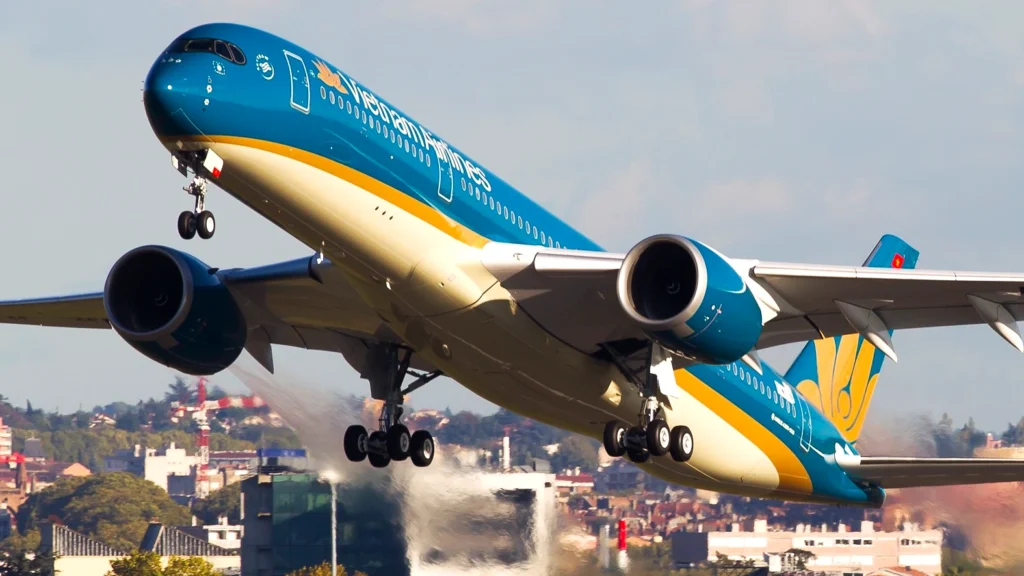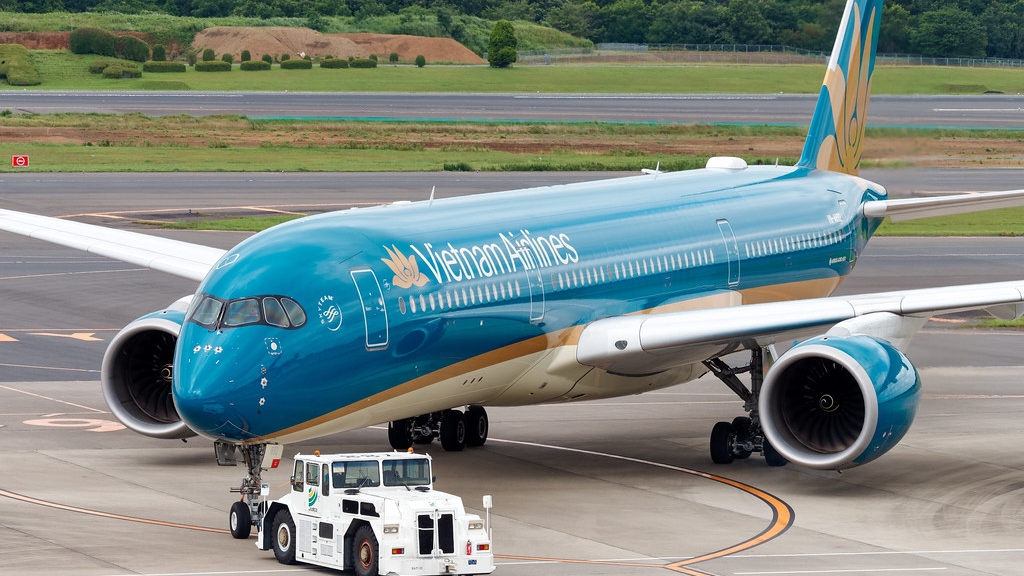
HANOI- Vietnam Airlines’ (VN) network analysis reveals significant market dynamics across its top 20 busiest routes, with the Hanoi (HAN) – Ho Chi Minh City (SGN) corridor maintaining dominance at 48% market share and 3.4 million passengers.
The carrier shows mixed performance trends, with notable growth in specific regional routes while facing challenges in others.
 Photo: Aero Icarus
Photo: Aero Icarus Top Busiest Routes of Vietnam Airlines
Vietnam Airlines’ (VN) route network showcases the dynamic air travel patterns across Vietnam and Southeast Asia, with its top 20 busiest routes revealing fascinating insights into regional connectivity.
Despite modest growth of 0.7% over three years and 0.1% in the last 12 months, this route remains crucial for domestic connectivity.
| 1 | Hanoi-Ho Chi Minh City | 3,447,000 | 48% | 1,654,560 | 0.1% |
| 2 | Da Nang-Hanoi | 1,341,000 | 46% | 616,860 | -0.6% |
| 3 | Da Nang-Ho Chi Minh City | 1,333,000 | 46% | 613,180 | -4.2% |
| 4 | Phu Quoc Isl.-Ho Chi Minh | 584,000 | 46% | 268,640 | -2.5% |
| 5 | Hue-Ho Chi Minh City | 469,000 | 43% | 201,670 | 0.5% |
| 6 | Hanoi-Nha Trang | 437,000 | 39% | 170,430 | 7.6% |
| 7 | Nha Trang-Ho Chi Minh | 400,000 | 53% | 212,000 | 1.0% |
| 8 | Ho Chi Minh City-Vinh | 392,000 | 34% | 133,280 | -4.5% |
| 9 | Haiphong-Ho Chi Minh | 371,000 | 31% | 115,010 | -2.4% |
| 10 | Ho Chi Minh-Con Dao Isl. | 314,000 | 87% | 273,180 | 22.0% |
| 11 | Da Lat-Ho Chi Minh City | 297,000 | 63% | 187,110 | 4.0% |
| 12 | Hanoi-Hue | 276,000 | 55% | 151,800 | 15.3% |
| 13 | Hanoi-Seoul | 253,000 | 22% | 55,660 | -4.2% |
| 14 | Bangkok-Ho Chi Minh City | 245,000 | 23% | 56,350 | 0.2% |
| 15 | Hanoi-Can Tho | 242,000 | 43% | 104,060 | 5.1% |
| 16 | Hanoi-Phu Quoc Island | 235,000 | 32% | 75,200 | 6.3% |
| 17 | Da Lat-Hanoi | 230,000 | 32% | 73,600 | 3.7% |
| 18 | Ho Chi Minh-Qui Nhon | 207,000 | 29% | 60,030 | -6.6% |
| 19 | Bangkok-Hanoi | 199,000 | 23% | 45,770 | -5.9% |
| 20 | Hanoi-Tokyo | 196,000 | 33% | 64,680 | -1.5% |
1. Hanoi (HAN) – Ho Chi Minh City (SGN)
- Passenger Volume: 3,447,000
- Market Share: 48%
- Vietnam Airlines Passengers: 1,654,560
- YoY Growth Rate: 0.1%
This premier domestic trunk route connects Vietnam’s political capital with its economic hub.
Despite intense competition, Vietnam Airlines maintains a strong market position, carrying nearly half the route’s passengers.
The minimal growth suggests market maturity and capacity optimization strategy.
2. Da Nang (DAD) – Hanoi (HAN)
- Passenger Volume: 1,341,000
- Market Share: 46%
- Vietnam Airlines Passengers: 616,860
- YoY Growth Rate: -0.6%
Linking central Vietnam’s largest city with the capital, this route serves both business and tourism sectors.
The slight decline in growth indicates market saturation and competitive pressures, though Vietnam Airlines maintains a significant market presence.
3. Da Nang (DAD) – Ho Chi Minh City (SGN)
- Passenger Volume: 1,333,000
- Market Share: 46%
- Vietnam Airlines Passengers: 613,180
- YoY Growth Rate: -4.2%
This key north-south corridor connects Vietnam’s largest tourism destination with its southern economic center.
The notable decline in growth suggests increased competition and possible market adjustments, despite maintaining strong market share.
4. Phu Quoc Island (PQC) – Ho Chi Minh City (SGN)
- Passenger Volume: 584,000
- Market Share: 46%
- Vietnam Airlines Passengers: 268,640
- YoY Growth Rate: -2.5%
Serving Vietnam’s largest island resort destination, this route primarily caters to leisure travelers. The declining growth rate might reflect seasonal variations and increasing competition in the tourism sector.
5. Hue (HUI) – Ho Chi Minh City (SGN)
- Passenger Volume: 469,000
- Market Share: 43%
- Vietnam Airlines Passengers: 201,670
- YoY Growth Rate: 0.5%
Connecting the former imperial capital with the southern metropolis, this route balances tourism and business travel.
The modest positive growth indicates stable demand and effective route management.
6. Hanoi (HAN) – Nha Trang (CXR)
- Passenger Volume: 437,000
- Market Share: 39%
- Vietnam Airlines Passengers: 170,430
- YoY Growth Rate: 7.6%
This route links the capital with a popular coastal resort city. Strong growth suggests increasing tourism demand and successful market development strategies.
7. Nha Trang (CXR) – Ho Chi Minh City (SGN)
- Passenger Volume: 400,000
- Market Share: 53%
- Vietnam Airlines Passengers: 212,000
- YoY Growth Rate: 1.0%
Serving the popular beach destination, this route maintains the highest market share among major tourist routes.
Steady growth indicates sustained tourism demand and effective capacity management.
8. Ho Chi Minh City (SGN) – Vinh (VII)
- Passenger Volume: 392,000
- Market Share: 34%
- Vietnam Airlines Passengers: 133,280
- YoY Growth Rate: -4.5%
This route connects the southern hub with north-central Vietnam. The declining growth and lower market share suggest strong competition and possible market saturation.
9. Haiphong (HPH) – Ho Chi Minh City (SGN)
- Passenger Volume: 371,000
- Market Share: 31%
- Vietnam Airlines Passengers: 115,010
- YoY Growth Rate: -2.4%
Linking Vietnam’s major port city with its economic center, this route serves primarily business travelers. The negative growth rate indicates increasing competition in the northern market.
10. Ho Chi Minh City (SGN) – Con Dao Island (VCS)
- Passenger Volume: 314,000
- Market Share: 87%
- Vietnam Airlines Passengers: 273,180
- YoY Growth Rate: 22.0%
This unique route serves a premium island destination with limited airline competition. The exceptional market share and strong growth demonstrate Vietnam Airlines’ dominance in specialized leisure markets.
11. Da Lat (DLI) – Ho Chi Minh City (SGN)
- Passenger Volume: 297,000
- Market Share: 63%
- Vietnam Airlines Passengers: 187,110
- YoY Growth Rate: 4.0%
Connecting the highland resort city with Ho Chi Minh City, this route shows strong performance with high market share. The positive growth reflects increasing tourism demand and business travel to the popular mountain destination.
12. Hanoi (HAN) – Hue (HUI)
- Passenger Volume: 276,000
- Market Share: 55%
- Vietnam Airlines Passengers: 151,800
- YoY Growth Rate: 15.3%
This cultural corridor linking the capital with the imperial city demonstrates robust growth. The strong market share and impressive growth rate indicate successful route development and increasing demand.
13. Hanoi (HAN) – Seoul (ICN)
- Passenger Volume: 253,000
- Market Share: 22%
- Vietnam Airlines Passengers: 55,660
- YoY Growth Rate: -4.2%
This international route faces strong competition from Korean carriers. The lower market share and negative growth suggest challenges in maintaining market position in this highly competitive corridor.
14. Bangkok (BKK) – Ho Chi Minh City (SGN)
- Passenger Volume: 245,000
- Market Share: 23%
- Vietnam Airlines Passengers: 56,350
- YoY Growth Rate: 0.2%
A key Southeast Asian route connecting two major regional hubs. The modest market share and minimal growth reflect intense competition from both legacy and low-cost carriers.
15. Hanoi (HAN) – Can Tho (VCA)
- Passenger Volume: 242,000
- Market Share: 43%
- Vietnam Airlines Passengers: 104,060
- YoY Growth Rate: 5.1%
Linking the capital with the Mekong Delta’s largest city, this route shows healthy growth. The positive performance indicates successful market development in secondary cities.
16. Hanoi (HAN) – Phu Quoc Island (PQC)
- Passenger Volume: 235,000
- Market Share: 32%
- Vietnam Airlines Passengers: 75,200
- YoY Growth Rate: 6.3%
This leisure-focused route demonstrates strong growth despite competitive pressures. The positive trajectory suggests increasing northern demand for southern island tourism.
17. Da Lat (DLI) – Hanoi (HAN)
- Passenger Volume: 230,000
- Market Share: 32%
- Vietnam Airlines Passengers: 73,600
- YoY Growth Rate: 3.7%
Connecting the highland city with the capital shows steady growth. The moderate market share and positive growth indicate balanced competition and growing demand.
18. Ho Chi Minh City (SGN) – Qui Nhon (UIH)
- Passenger Volume: 207,000
- Market Share: 29%
- Vietnam Airlines Passengers: 60,030
- YoY Growth Rate: -6.6%
This coastal city connection shows challenging performance. The declining growth and lower market share suggest strong competitive pressures in developing markets.
19. Bangkok (BKK) – Hanoi (HAN)
- Passenger Volume: 199,000
- Market Share: 23%
- Vietnam Airlines Passengers: 45,770
- YoY Growth Rate: -5.9%
Another major regional route facing significant competition. The negative growth and low market share reflect challenges in the competitive international market.
20. Hanoi (HAN) – Tokyo (NRT/HND)
- Passenger Volume: 196,000
- Market Share: 33%
- Vietnam Airlines Passengers: 64,680
- YoY Growth Rate: -1.5%
This important East Asian route maintains a moderate market share despite competition. The slight decline suggests market adjustments and competition from both Japanese and Vietnamese carriers.
 Photo: Nabil Molinari | Flickr
Photo: Nabil Molinari | Flickr Market Performance Analysis
Vietnam Airlines demonstrates varied performance across its busiest network, with domestic routes showing greater resilience compared to international services.
The carrier maintains dominant market shares in key domestic trunk routes, particularly achieving 48% market share on the crucial Hanoi-Ho Chi Minh City route with 3.44 million passengers.
Notably, specialty routes like Ho Chi Minh-Con Dao Island showcase exceptional performance with 87% market share and 22% year-over-year growth, indicating strong positioning in niche markets.
The airline’s market presence varies significantly between domestic and international sectors. While domestic routes typically maintain 40-60% market share, international routes to Bangkok, Seoul, and Tokyo show lower market shares of 22-33%, reflecting intense competition in these markets.
This disparity suggests stronger competitive advantages in the domestic market where the carrier leverages its extensive network and brand recognition.
 Photo: Clément Alloing
Photo: Clément AlloingRoute Performance
The route network demonstrates three distinct performance tiers:
- Premium Domestic Routes:
- The Hanoi-Ho Chi Minh City corridor remains the backbone operation with 3.44 million passengers
- Da Nang connections to both Hanoi and Ho Chi Minh City maintain strong 46% market shares despite recent negative growth
- Tourist routes like Con Dao and Phu Quoc show robust performance with high market shares
- Secondary City Pairs:
- Routes connecting secondary cities show mixed results
- Positive growth in routes like Hanoi-Hue (15.3% growth) and Hanoi-Can Tho (5.1% growth)
- Some routes face challenges, such as Ho Chi Minh-Qui Nhon with -6.6% growth
- International Routes:
- Generally lower market shares but significant volume
- Bangkok routes maintaining 23% market share
- Seoul route showing -4.2% growth despite strategic importance
- Tokyo route holding 33% market share despite -1.5% growth
 Photo: Melvin Loi | Flickr
Photo: Melvin Loi | FlickrBroader Implications
The data reveals several strategic implications for Vietnam Airlines:
- Network Strategy:
- Strong focus on maintaining domestic market leadership
- Selective international route development facing increasing competition
- Strategic importance of tourist destinations in route portfolio
- Market Position:
- Clear domestic market leadership in key routes
- Challenged position in international markets requiring strategic review
- Successful niche market operations (e.g., Con Dao route)
- Future Opportunities:
- Potential for growth in secondary city pairs showing positive trends
- Need for strategic response to international route challenges
- Opportunity to leverage strong domestic network for international feed
The overall picture suggests a carrier successfully defending its domestic position while facing challenges in international markets.
The varying performance across routes indicates a need for targeted strategies to address specific market conditions and competitive pressures.
The strong performance in busiest tourist routes and some secondary markets suggests potential areas for future growth and network optimization for Vietnam Airlines.
Stay tuned with us. Further, follow us on social media for the latest updates.
Join us on Telegram Group for the Latest Aviation Updates. Subsequently, follow us on Google News
The post Top 20 Busiest Routes of Vietnam Airlines appeared first on Aviation A2Z.














